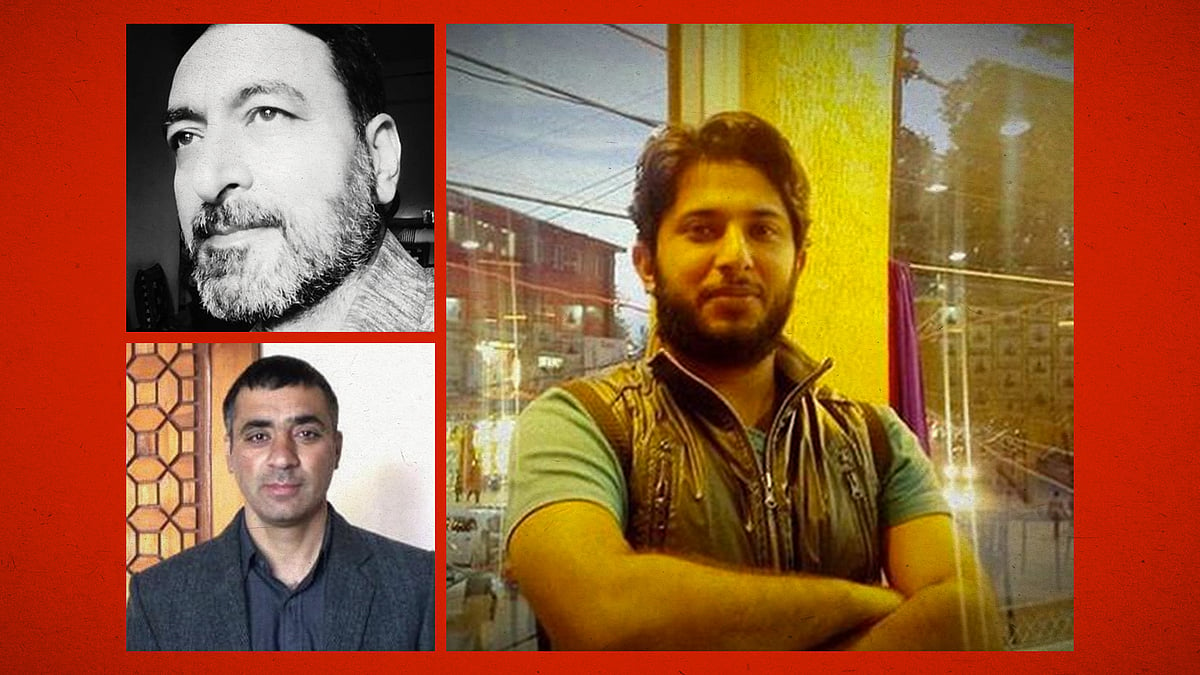‘Survived the storm but killed by a splinter’: Kashmiri minorities fear return of the 1990s
Many believe the government’s policies have made minorities vulnerable to attacks by militants.
On Thursday afternoon, Jasleen Kour, a student of Class 7, and her younger brother Jasjeet Singh, who’s in Class 3, were disturbed by a rush of visitors at their home in Srinagar’s Allochi Bagh. Dozens of women waited in the rooms below while men sat outside in the garden, shaded by a tarpaulin due to an unseasonably warm October.
Jasleen, Jasjeet and the visitors were waiting for the return of Supinder Kour, her mother, who had gone out on the morning of October 7 to a government-run higher secondary school in downtown Srinagar’s Eidgah.
But Supinder, 46, the principal of the school, had no inkling that she would be the latest fatality in a wave of killings of civilians by militants. She was shot dead with her colleague from Jammu, Deepak Chand, inside the school premises in broad daylight. According to reports, Supinder and Deepak were singled out for being non-Muslim.

In the first week of October, militants have shot dead five civilians, four of which were members of minority communities. Addressing reporters outside the school where Deepak and Supinder were killed, director general of police Dilbagh Singh said the attack was “an attempt to defame local Muslims of Kashmir."
“Killing innocent civilians, including teachers, is a move to attack and damage the age-old tradition of communal harmony and brotherhood in Kashmir,” he said.
Back in Allochi Bagh, the uneasy calm in Jasleen’s home was broken by the wails of women as Supinder’s body arrived in a shroud. As mourners, including the family’s Muslim friends and colleagues, poured in, one question was asked again and again, “Why was she killed? Was she part of the STF?”
The STF, or special task force, referring to the Special Operations Group, is a colloquial acronym for the police’s counterinsurgency unit. Sikhs comprise a miniscule minority in Kashmir, and there has been no violence against them in the recent past.
But now, fears have been renewed.
‘Target attacks’
The five killings come at a time when the Modi government continues to insist that the abrogation of Jammu and Kashmir’s residual autonomy had brought militancy down – a claim amplified by a majority of the national media.
However, while speaking to a reporter at a national news channel, an elderly Sikh mourner at Supinder’s home said: “They wanted to hoist the tricolour at schools at our expense. This is the truth that your channel won’t broadcast.”
A militant outfit called the Resistance Front, or TRF, claimed responsibility for the attacks. In a statement widely circulated in the media, the group said, “I want to make it clear that non-combatants become combatants when they try to fix themselves in the socks of the occupiers’ designs.” The police have maintained that the TRF is a front for the Pakistan-based Lashkar-e-Taiba.
The statement continued: “As already warned, anybody whosoever sides with the occupier and becomes their pawn in implementing nefarious designs of the occupier won’t be spared. These teachers had on August 15 harassed and warned the parents with dire consequences if any student didn’t attend the occupier regime’s August 15 filthy function at their school. Despite our warning posters and requests [not to] politicise the education system and [not to] drag education sector or any other public dealings into occupiers’ filthy agenda.”
In the three-decade long insurgency in Kashmir, symbols and proponents of Indian nationalism have long been vulnerable to attacks by militants, who aim to carve an independent state or accede to Pakistan.
Following the abrogation, New Delhi imposed several orders and policies that have opened up the region to non-natives. Since then, militant outfits have repeatedly warned against such moves and threatened non-natives procuring domicile certificates under the new laws.
However, Supinder and Deepak were neither non-natives nor the only teachers to have hoisted the tricolour. After government directives and threats of punishment, all government employees, the majority of whom in Kashmir are Muslim, observed Independence Day celebrations.
The killing of Supinder, said Santpal Singh, a Sikh community leader, “is a conspiracy to throw us out of Kashmir.” He asked that “everyone condemn this irrespective of their faith. We request the majority community to support the minority and bring the killers” before the public.
According to the police, 28 civilians have been killed this year so far, of which seven were non-Muslims.
In the first week of this month, three Muslims and four non-Muslims were killed in, according to statements circulated in the name of the TRF, “target attacks."
Five of them were civilians. On October 5, three civilians – Makhan Lal Bindroo, a Kashmiri Pandit who was a renowned pharmacist; Virendar Paswan, a street food vendor; and Mohammad Shafi Lone, a taxi driver – were killed in three separate attacks. On October 2, two civilians, Majid Ahmad Gojri and Mohammad Shafi Dar, were killed in two separate attacks.
Five of the six attacks occurred in Srinagar city, where militant attacks are fewer.
‘Soft targets’
On Wednesday, the day after Makhan Lal, 62, was killed at the pharmacy he ran for decades, his son Siddharth Bindroo attended to a rush of mourners at their residence in Srinagar’s Indra Nagar, a few yards from the residence of jeweller Satpal Nishcal, whose killing was also claimed by the TRF, which gave his acquiring a domicile certificate as the reason.
The jeweller’s killing had sparked some fears but Makhan Lal stayed put, just as he had all through the peak of the anti-India insurgency because of which the majority of Kashmiri Pandits had fled into exile. Over the years, Makhan Lal had made a name for himself and expanded his business to a polyclinic.
“He survived the storm but was killed by a splinter,” his son told a group of reporters.
Siddharth said his father “represented a community that decided to stay back and not leave the valley”.
“When you kill such a person, you create ripples across,” he said. “And I think when there is no news left to be made [and] the means are not available, the simplest thing is to find some soft target and create some news.”

A statement attributed to the TRF termed Makhan Lal an “RSS stooge”. In response, Siddharth said, “Had my father’s dead body been here, we would have got up and laughed.”
He likened it to the stereotyping of Muslims with global Islamist outfits like the Al-Qaeda. “The moment you use any name which has been branded...The concept that is created is not RSS, it's the word ‘stooge’. You name anyone as a ‘stooge’ and you can kill them.”
He added that the wave of killings were driven by “the fear and phobia of a demographic change that has been put in the minds of the masses”. And if these killings aren’t stemmed, “there will be a rift which will never go”.
“They [militants] will keep on hammering until maybe people say ‘no, this is too much’,” he said. “But I am telling you, as a person who has lost his father, that this is never going to be too much. But what about if this happens to other people? Will they stay or not? The [answer] is not known to us.”
Return to the 1990s
But the governments in Jammu and Kashmir and at the centre are oblivious to the threats faced by minorities, said Sanjay Tikoo, a prominent Kashmiri Pandit leader who heads the Kashmiri Pandit Sangharsh Samiti, an association of minority families that chose to stay in Kashmir despite militant threats.
Already, he told Newslaundry, at least 60 families will leave the valley in the coming days.
Besides government policies pitting minorities against the majority, Sanjay said there were also security lapses on part of the establishment, for which “heads should roll”. He demanded to know how militants were able to move around “when you and I are being harassed by security forces to prove our identity and thrashed if not” in the fortified Srinagar city.
Sanjay believes that the BJP has sought to reap political benefits out of the plight of Kashmiri Pandits, but the party is not “serious about the security of minorities”. For over a year, his requests for a meeting with lieutenant governor Manoj Sinha have been ignored.
In a letter to Sinha, a copy of which was sent to the ministry of home affairs as well and made public by his organisation, Sanjay noted that “since the abrogation of Article 370 and it has now stooped down on shroud politics to justify your government’s stand on the issues related to the UT of Jammu and Kashmir in general and Kashmir Valley in particular.”
Thursday’s attack, Sanjay said, had reminded him of the 1990s when Kashmiri Pandits were targeted and killed. “The same thing is happening today also. Back then, there was no threat to the Sikh community. But this time, minorities are on the gunman’s radar.”
What was also similar to the 1990s, he said, is the “silence of the majority community”. He rued: “The onus is on the majority community. If the killings are wrong, the fifth of this month“ – when Makhan Lal Bindroo was killed – “should have been observed as a black day in Srinagar but everyone was enjoying their feasts. People should have been on the roads [in solidarity].”
For him, this once again brought home the realisation that the “majority within the majority community is not ready for the minorities in Kashmir”.
This sense of fear is shared by others in the Kashmiri Pandit community that still reside in the valley. “The fear is different this time,” said a young Kashmiri Pandit, a government employee. “In the 1990s, news of killings reached late. But this time, it's all happening in real time, and rumours and fake news are also spreading faster and creating panic.”
In the end, he said, it was about perspective. “If we have to live here, we have to live with it. Somebody has to live in Kashmir. If people chose to stay back in the 1990s, there will be people who will again choose to still stay here.”
 Amid escalating crackdown on Kashmir’s media, police raid four journalists
Amid escalating crackdown on Kashmir’s media, police raid four journalists Kashmir governor’s public relations blitz leaves the press in tatters
Kashmir governor’s public relations blitz leaves the press in tatters